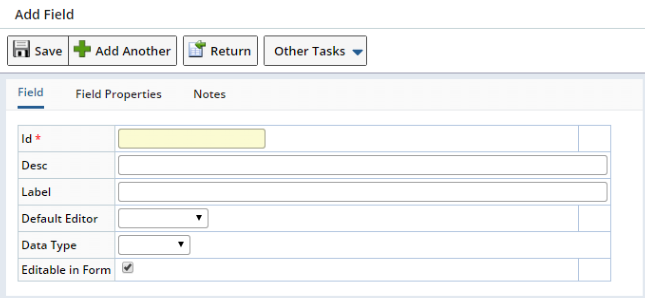Overview |
|
|
Field Definitions (Lab Admin → eForms → Field Definitions) and Formlet Definitions (Lab Admin → eForms → Formlet Definitions) are SDCs that:
| • | Let you build a library of reusable Fields and Formlets for use in Forms, allowing "common data elements" to be defined among multiple Forms, thus promoting standardization and uniformity of naming and layout. |
| • | Are reproductions of Fields and Formlets in the Form Builder. As such, their properties are explained in the Fields section of the Form Bulder documentation. After creating a Field Definition or Formlet Definition, use the Controlled Field and Insert Formlet controls in the Form Builder to insert them into a Form. Additionally, existing Form and Formlet objects on an existing Form can be reverse-engineered to Fields and Formlet Definitions. |
| • | Facilitate data mining. |
As usual, each of these opens a MaintenanceList page showing existing Form and Formlet Definitions, with the standard "Add" and "Edit" buttons.
Field Definitions |
|
|
A Field Definition:
| • | Promotes a "controlled vocabulary" that mandates the use of predefined terms (rather than a "natural language vocabulary" with no restrictions). |
| • | Has no layout definition. |
| • | Has properties that map directly to those in the Form Builder. All Form Builder properties are available for definition, with the excpetion that only a single Label can be defined in a Field Definition. |
Also:
| • | A Field Definition cannot be added to a Form if the Field identifiers clash. |
| • | Fields are merged with the existing Form when selected for a new Form. |
| • | After the merge, updates to the Field Definition do not update the Form. |
| • | Field properties can be locked in the new Form. However, the Field identifier cannot be changed. |
| • | An "Add" button on the list page lets you add Fields as you go. |
| • | In the Form Builder, you can use the "Save As Field" function in the Objects Frame Context Menus for Fields to save any Field as a Field Definition. |
| • | Checking "Editable in Form" allows the Field to be edited in the Form Builder. |

|
After adding a Field Definition, use the "Field Properties" tab to specify properties in the same manner as you would in the Form Builder.
Formlet Definitions |
|
|
A Formlet Definition:
| • | Promotes a standard interface. |
| • | Defines a "mini Form", including Field properties and layout. |
| • | Is hosted on an HTML div. |
Also:
| • | Formlets are merged with the existing Form when selected for a new Form. |
| • | Formlets become Sections in the new Form. |
| • | You can add a Formlet to a Form "By Reference" to update the Form when the Formlet Definition is updated. See Insert Formlet (in the Form Builder Overview). |
| • | Formlet contents and layout can be locked in the new Form. |
| • | Formlets can be added to other Formlets. |
| • | The width of a Formlet can be dragged to the desired size in the Form Builder. The resulting size is reflected when the Formlet is inserted into a Page. |
| • | Formlets are Versioned. |

|
| Editable in Form | Allows the Formlet to be edited in the Form
Builder:
Also see Insert Formlet (in the Form Builder Overview) and Formlet (in Form Builder Sections). |
||||||
| Allow AutoSave Binding | Adds a Datasource Binding: Binding Mode property for Fields. |
After adding a Formlet Definition, use the "Formlet Builder" button or "Formlet Layout" tab to open a version of the Form Builder, where you build a Formlet in the same manner as you would build a Form.
Groovy in Field and Formlet Definitions |
|
|
Noteworthy cautions:
| • |
Beware of writing Groovy script that refers to other form objects. For example, consider a Field defined by a SQL-based dropdown of Batches that is dependent on a supplier: "select s_batchid from s_batch where supplier = '${fields.supplier}'" This dropdown will always be empty if there is no "supplier" Field on the Form. |
| • |
Certain code references may cause errors (null). For example: fields.supplier.length() > 0 ? "select s_batchid from s_batch where supplier = '${fields.supplier}'" : "select s_batchid from s_batch" |